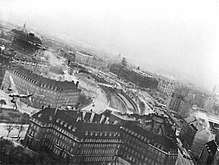Operation Carthage
Operation Carthage, on 21 March 1945, was a British air raid on Copenhagen, Denmark during the Second World War which caused significant collateral damage. The target of the raid was the Shellhus, used as Gestapo headquarters in the city centre. It was used for the storage of dossiers and the torture of Danish citizens during interrogations. The Danish Resistance had long asked the British to conduct a raid against the site. The building was destroyed, 18 prisoners were freed and Nazi anti-resistance activities were disrupted. Part of the raid was mistakenly directed against a nearby school; the raid caused 125 civilian deaths (including 86 schoolchildren and 18 adults at the school). A similar raid against the Gestapo headquarters in Aarhus, on 31 October 1944, had succeeded.
| Operation Carthage | |||||||
|---|---|---|---|---|---|---|---|
| Part of the Second World War | |||||||
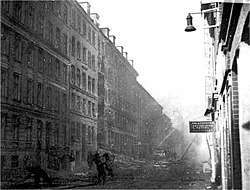 The air raid on the Shellhus | |||||||
| |||||||
| Belligerents | |||||||
|
|
| ||||||
| Strength | |||||||
| 20 bombers, 30 fighters | Various antiaircraft defences | ||||||
| Casualties and losses | |||||||
|
6 aircraft destroyed 9 aircrew killed 1 aircrew captured |
The Danish headquarters of the Gestapo destroyed 55 German soldiers and 47 Danish employees of the Gestapo killed | ||||||
|
125 Danish civilians killed, including 86 schoolchildren 8 Danish prisoners of the Gestapo killed | |||||||
Background
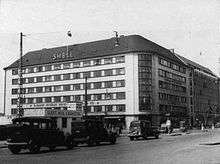
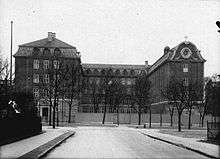
The raid was requested by members of the Danish resistance movement to free imprisoned members and to destroy the records of the Gestapo, to disrupt their operations. The RAF initially turned down the request as too risky, due to the location in a crowded city centre and the need for low-level bombing but they approved the raid in early 1945 after repeated requests. Once approval had been given, planning for the raid took several weeks; scale models of the target building and the surrounding city were built for use by pilots and navigators in preparation for a very low-level attack.
Raid
The attacking force consisted of Royal Air Force de Havilland Mosquito F.B.VI fighter-bombers of No. 140 Wing RAF, comprising No. 21 Squadron RAF, No. 464 Squadron RAAF, and No. 487 Squadron RNZAF. The aircraft flew in three waves of six aircraft, with two reconnaissance Mosquito B.IVs from the Royal Air Force Film Production Unit to record the results of the attack. Thirty RAF Mustang fighters gave air cover from German aircraft and these also attacked anti-aircraft guns during the raid.
The force left RAF Fersfield in the morning and it reached Copenhagen after 11:00. The raid was carried out at rooftop level and during the first attack, a Mosquito hit a lamp post, damaging its wing and the aircraft crashed into the Jeanne d'Arc School, about 1.5 km (0.93 mi) from the target, setting it on fire. Several bombers in the second and third wave attacked the school, mistaking it for their target.[1]
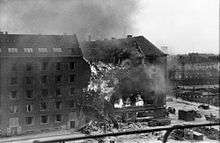
Results
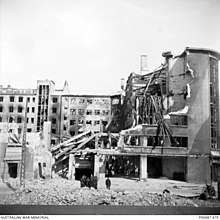
On the following day, a reconnaissance plane surveyed the target to assess the results. The damage was severe, with the west wing of the six-storey building reduced nearly to ground level. The Danish underground supplied a photograph showing the building burning from end to end.
The raid had destroyed the Gestapo headquarters and records, severely disrupting Gestapo operations in Denmark, as well as allowing the escape of 18 prisoners. Fifty-five German soldiers, 47 Danish employees of the Gestapo and eight prisoners died in the headquarters building. Four Mosquito bombers and two Mustang fighters were lost and nine airmen died on the Allied side. At the Jeanne d'Arc School, 86 schoolchildren and 18 adults were killed, many of them nuns.[1]
On 14 July 1945, remains of an unidentified male casualty were recovered from the ruins of the Shellhus and transferred to the Department of Forensic Medicine of the University of Copenhagen. This happened again four days later and the two casualties were buried in Bispebjerg Cemetery on 4 and 21 September, respectively.[2]
See also
- Aarhus Air Raid, a similar attack on Gestapo headquarters in Aarhus, Denmark
- Operation Jericho, a similar attack on Amiens Prison in France
- Oslo Mosquito raid, a similar attack on Gestapo headquarters in Oslo, Norway
References
- Notes
- Rasmussen, Anita Brask (21 March 2012). "Bombningen af Den Franske Skole blev redigeret ud af erindringen" [The bombing of the French School was edited out of the remembrance] (in Danish). Dagbladet Information. Retrieved 4 December 2014.
- "Døde Mandkøn" [Deceased Males]. Kirkebog [Parish Register]. 1930-1946 (in Danish). Skt. Johannes. 1945. p. 372.
Ukendt Mand. (Ligrester). Fundet død i Shellhusets Ruiner. Ført til Retsmedicinsk Institut
- Bibliography
- "Attack on Gestapo Headquarters, Copenhagen, 21 March 1945", RAF History Site: Bomber Command Famous Raids, archived from the original on 1 January 2018, retrieved 14 June 2011
- Matthias Bath: Danebrog gegen Hakenkreuz, Der Widerstand in Dänemark 1940–1945, Wachholtz 2011, ISBN 978-3-529-02817-5
External links
- (DK in English) On the entire event
- (DK in Danish, encyclopaedic) On the French School (encyclopedic)
- (DK in Danish, encyclopedic) On the Shell office building (encyclopedic)
- (DK in Danish) On the bombing of the French School
| Wikimedia Commons has media related to Operation Carthage. |
- "RAF - Attack on Gestapo Headquarters". Royal Air Force. Archived from the original on 1 January 2018. Retrieved 21 April 2015.
- IWM Interview with RAF officer Edward Sismore, who participated in the raid
- Velschow, Klaus. "The Bombing of the Shellhus on March 21, 1945". milhist.dk. Archived from the original on 10 April 2014. Retrieved 21 April 2015.
- "Video of British air raid on Copenhagen 1945". militaryphotos.net. Archived from the original on 17 July 2014. Retrieved 21 April 2015.
